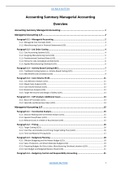Summary
Summary Accounting IBA (Managerial part, E_IBA1_ACC)
- Course
- Institution
- Book
This summary covers the second part of the course Accounting for the BSc International Business Administration at VU Amsterdam. It involves - inter alia - budgetary planning, pricing, job order costing, ABC, incremental analysis, sales mix, break-even analysis, cost-volume-profit, and other mana...
[Show more]



